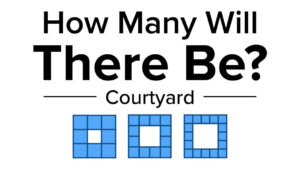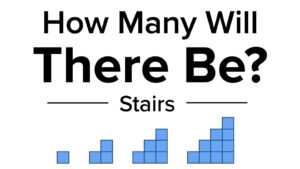Grade 5
-
Geometry
-
Measurement & Data
-
Numbers & Operations: Base Ten
-
Numbers & Operations: Fractions
-
Operations & Algebraic Thinking
-
Writing
CCSS Math Standard: 5.OA.3

Math Curiosity: Magic Triangles
Can you make each side of this triangle add up to 9 using the digits 1-6?

How Many Will There Be? Chip Off The Block
Give kids a taste of a sequence, let them build an understanding, and then see how far their predictions can take them.

How Many Will There Be? Earthworm
Give kids a taste of a sequence, let them build an understanding, and then see how far their predictions can take them.

How Many Will There Be? Courtyard
Give kids a taste of a sequence, let them build an understanding, and then see how far their predictions can take them.

How Many Will There Be? Checkerboard
Give kids a taste of a sequence, let them build an understanding, and then see how far their predictions can take them.

How Many Will There Be? Crosses
Give kids a taste of a sequence, let them build an understanding, and then see how far their predictions can take them.

How Many Will There Be? Squares in Squares
Give kids a taste of a sequence, let them build an understanding, and then see how far their predictions can take them.

How Many Will There Be? Pyramids
Give kids a taste of a sequence, let them build an understanding, and then see how far their predictions can take them.

How Many Will There Be? Sliced Circles
Give kids a taste of a sequence, let them build an understanding, and then see how far their predictions can take them.

How Many Will There Be? Xs and Os
Give kids a taste of a sequence, let them build an understanding, and then see how far their predictions can take them.

How Many Will There Be? Desks
Give kids a taste of a sequence, let them build an understanding, and then see how far their predictions can take them.

How Many Will There Be? Stairs
Give kids a taste of a sequence, let them build an understanding, and then see how far their predictions can take them.

How Many Will There Be? Flowers
These flowers sure are getting bigger faster! How large will they be in step 10? What about step 50?

How Many Will There Be? Triangles Within Triangles
A triangle splits and splits and splits again. How many will there be in step 20?

Math Curiosity: Klauber’s Triangle
In 1932, a leading authority on rattlesnakes, Laurence Klauber, discovered a startling pattern within a triangle of primes.

Math Curiosity: A Pattern Packed Triangle
Pascal’s pattern-packed triangle is a potent puzzle for pupils to ponder.

Analyzing Movies’ Success
So should we make another movie in this series?

Doubling Dollars
Say you have a dollar. Say you can double that dollar each day: $1, $2, $4, and so on. How long will it take to reach… one million dollars? Not as long as you might think!